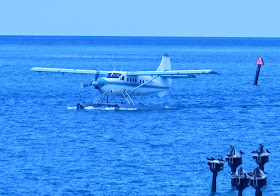June 9th
Day One - The Keys
Bob Pelkey picked me up at Three
AM for our annual birding trip to the Florida Keys. This year we added a day to visit Dry
Tortugas National Park.
Our goals for this trip were for birds primarily found in the Keys including White-crown
Pigeon, Rosette Tern, Antillean Nighthawk, Black-whiskered Vireo, Brown Noddy, Masked
Booby and Shiny Cowbird.
Card Sound Road
 |
| White-crowned Pigeon |
Our early start was timed for an arrival at sunrise at the
Card
Sound Road toll booth. This location can be an
excellent location for finding Black-whiskered Vireo and Cuban Golden
Warblers.
This warbler is a
Caribbean
subspecies of the Yellow Warbler and its only
U.S.
range is in the mangroves of the
Florida Keys. So we
expected to find and photograph these birds, but upon arrival found that the
location had been taken over by
KZK Productions for filming a new series forNetflix. We did manage to hear
Prairie
Warbler and a
Black-whiskered Vireo
as we moved on.
The next stop was three down the road just before
Sound
Card Road meets 905. Here we were looking for a neotropic
cormorant that had been reported at this location for the past three days. We didn't
see any cormorants at all, but had good showings of
White-crowned Pigeon, Green
 |
| Common Nighthawk |
Herons, Gray Kingbird and a very
cooperative
Common Nighthawk.
Dagny Johnson Key Largo Hammock Botanical State
Park
Next stop was on
Key Largo near were 905 intersects with Highway 1. Dangy Johnson can be a good
location for Mangrove Cuckoo and Black-whiskered Vireo. I've seen both here in the past, but not
today. Did sight White-crowned Pigeon,
 |
| A young White-eyed Vire |
White-eyed Vireo and heard a Yellow-billed
Cuckoo. Bob also located an interesting lizard called a Bark Anole.
 |
| Bark Anole |
Marathon Government Buildings
Nesting Rosette
Terns along with nesting Least Terns can be found this time of year around the
Marathon Government Complex. We were succesfull, finally, in locating a targeted
species with seeing the Rosette Terns.
Magnificent Frigetbirds, Least Terns and Laughing Gulls were also seen here.
 |
| Rosette Terns in Marathon |
Curry Hammock State Park
Curry Hammock is a small park with access on Little Crawl
Key and is know for the
annual Fall Hawk Watch located here. We did not see
much on our stop. A
Gray Kingbird
posed for us and a couple of
Ground
Doves were active, but mostly the activity we saw were the basking
Green Iguanas.
 |
| Gray Kingbird |
 |
| Adult Green Iguana |
 |
| Juvinile Green Iguana |
 |
| Large Green Iguana |
Key
West and Ft
Taylor State Park
Arriving in
Key West
around
noon we scouted out the island
and stopped at
Ft Zackary Taylor State Park.
Found the park fairly quiet. A few
White-crowned
Pigeons, Least Terns and
Common
Grackles. Would have been nice to find some
Caribbean
vagrants but mostly found more
Green
Iguana. On the island we saw lots of the
Key West chickens, Gray Kingbirds, White-crowned
Pigeons and
White-winged Doves.
 |
| A scene from Ft Taylor |
 |
| White-crowned Pigeon |
 |
| Green Iguana |
Middle Torch Key
Made a stop on
Middle Torch Key
Road, after leaving
Key West
as we were returning to
Marathon, to look for
Black-whiskered Vireos, which we did
find along with more
Gray Kingbirds
and a
Key Deer.
 |
| Key Deer in velvet |
 |
| Black-whiskered Vireo |
Marathon Airport
 |
| Bob Pelkey waiting for the nighthawks to arrive |
After checking into the motel in Marathon
and getting some rest, we headed over to the nearby airport to await the
arrival of any Antillean Nighthawks
at sun down. As we waited several Laughing
Gulls passed by, plus more White-crowned
Pigeons, Kingbirds, Least Tern and even an unidentified parrot. Finally at seven forty-five we first heard then spotted a
lone Antillean Nighthawk soaring above the airport runway. But it quickly left
the area toward the northeast. By eight o'clock
a pair of Antillean Nighthawks appeared, again, briefly, which ended the day's
birding.
































.jpg)















